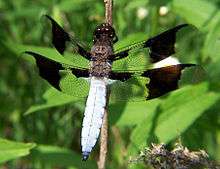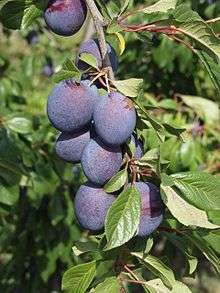Pruinescence
Pruinescence /ˌpruːɪˈnɛsəns/,[1] or pruinosity, is a "frosted" or dusty looking coating on top of a surface. The adjectival form is pruinose /ˈpruːɪnoʊs, -z/.


Entomology
In insects, a "bloom" caused by wax particles on top of an insect's cuticle that covers up the underlying coloration, giving a dusty or frosted appearance. The pruinescence is commonly white to pale blue in color, but can also be gray, pink, purple, or red; these colors may be produced by Tyndall scattering of light. When pale in color, pruinescence often strongly reflects ultraviolet.[2]
Pruinescence is found in many species of Odonata, particularly damselflies of the families Lestidae and Coenagrionidae, where it occurs on the wings and body. Among true dragonflies it is most common on male Libellulidae (skimmers).[2]
In the Common Whitetail and Blue Dasher dragonflies (Plathemis lydia and Pachydiplax longipennis), males display the pruinescence on the back of the abdomen to other males as a territorial threat.[3] Other Odonata may use pruinescence to recognize members of their own species or to cool their bodies by reflecting radiation away.[2]
Plants, fungi, and lichens
The term pruinosity is also applied for "blooms" on plants, for example on the skin of grapes[4] and also to powderings on the cap and stem of mushrooms, which can be important for identification.
It may also be called a pruina (plural: pruinae), using the Latin word which gave rise to the various English terms.[5][6]
An epinecral layer is "a layer of horny dead fungal hyphae with indistinct lumina in or near the cortex above the algal layer.[6]
References
- "pruinescence, n." Oxford English Dictionary, Third edition, September 2007; online version. Oxford University Press. September 2011. Retrieved 8 December 2011.
- Corbet, Phillip S. (1999). Dragonflies: Behavior and Ecology of Odonata. Ithaca, NY: Cornell University Press. pp. 281–282. ISBN 0-8014-2592-1.
- Johnson, Clifford (1962). "A Study of Territoriality and Breeding Behavior in Pachydiplax longipennis Burmeister (Odonata:Libellulidae)". The Southwestern Naturalist. 7 (3/4): 191–197. doi:10.2307/3668841. JSTOR 3668841.
- ‘Sangiovese’ and ‘Garganega’ are two key varieties of the Italian grapevine assortment evolution Archived 2011-07-19 at the Wayback Machine, M. Crespan, A. Calò, S. Giannetto, A. Sparacio, P. Storchi and A. Costacurta, Vitis 47 (2), 97–104 (2008); p. 98-99 discusses different phenotypes of Vitis vinifera 'Catarratto' showing varying pruinosity
- See Wiktionary entry.
- Pruina as a Taxonomic Character of the Lichen Genus Dermatocarpon, Starri Heidmarsson, The Bryologist Vol. 99, No. 3 (Autumn, 1996), pp. 315-320,